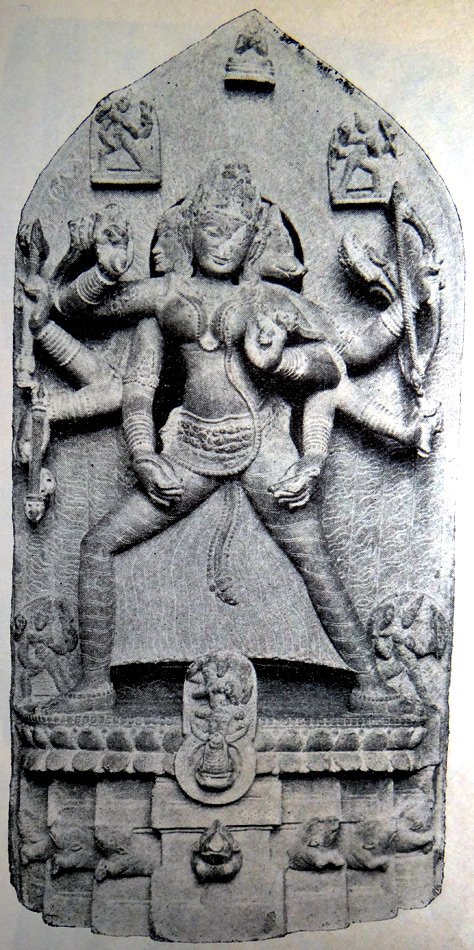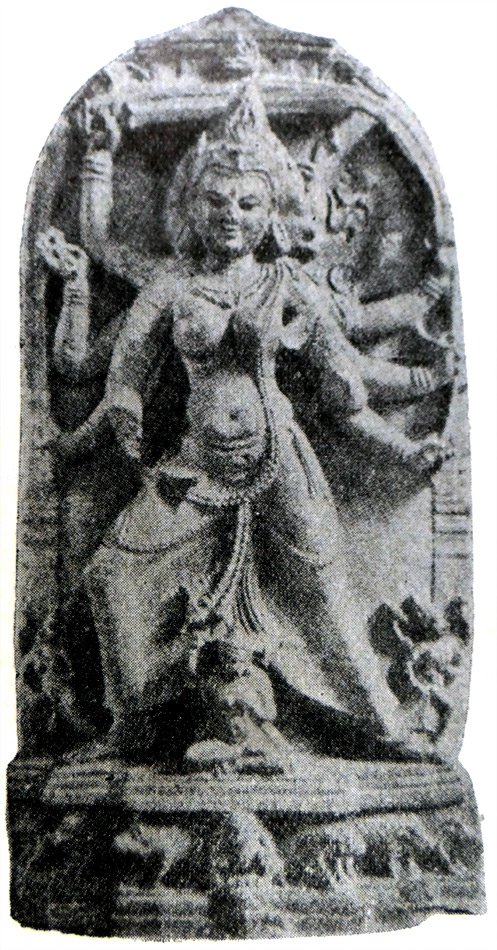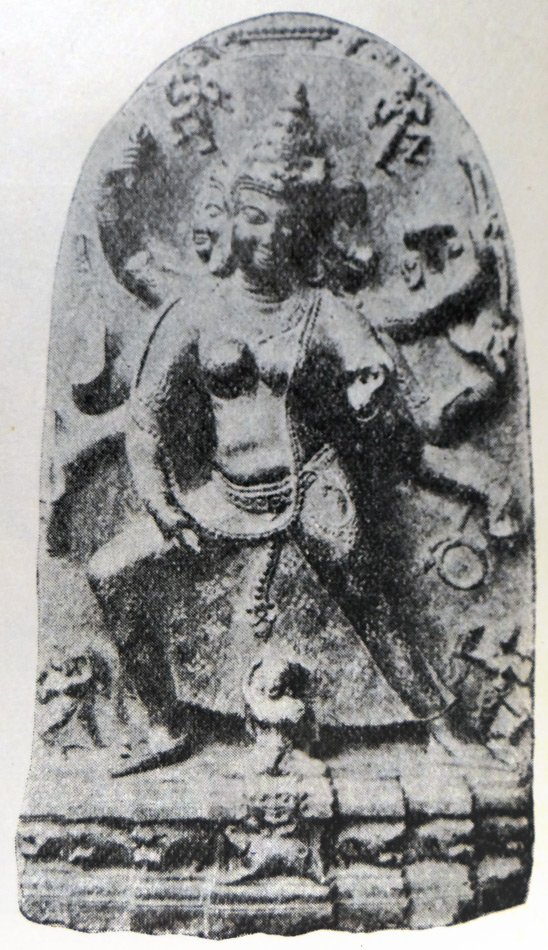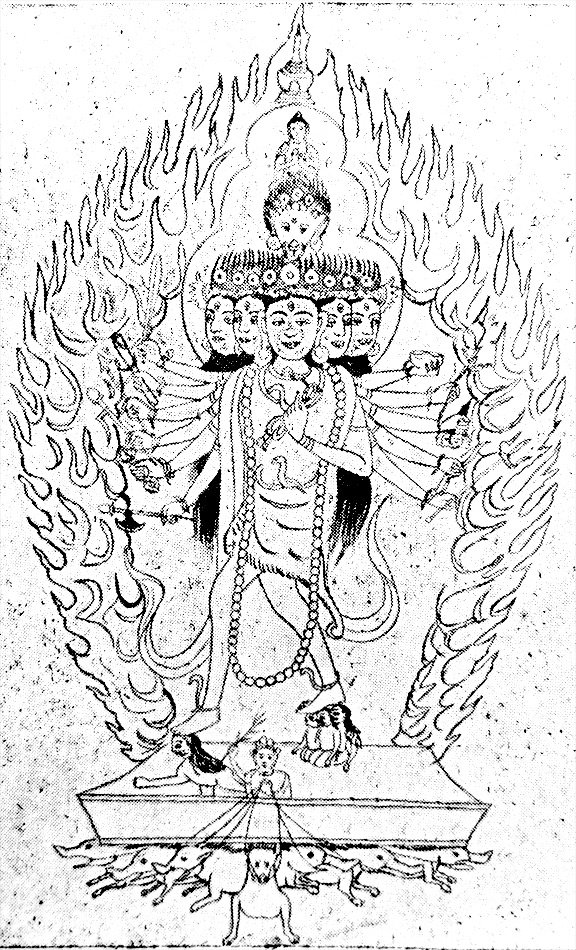The Indian Buddhist Iconography
by Benoytosh Bhattachacharyya | 1958 | 51,392 words | ISBN-10: 8173053138 | ISBN-13: 9788173053139
This page contains an iconography image of Emanations of Vairocana: Ashtabhuja and Dashabhujasita Marici and represents figure 152-155 of the book Indian Buddhist Iconography, based on extracts of the Sadhanamala English translation. These plates and illustrations represent either photographs of sculptures or line-drawing reproductions of paintings or other representations of Buddhist artwork.
Figure 152-155 - Emanations of Vairocana: Aṣṭabhuja and Daśabhujasita Mārīcī
 Fig. 152: Aṣṭabhuja Mārīcī (Indian Museum) |
 Fig. 153: Aṣṭabhuja Mārīcī (Indian Museum) |
 Fig. 154: Aṣṭabhuja Mārīcī (Lucknow Museum) |
 Fig. 155: Daśabhujasita-Mārīcī |
Mārīcī is invoked by the Lamas of Tibet about the time of sun-rise, which shows her connection with the sun. She too, like the Hindu Sun-god, has a chariot. Her chariot is drawn by seven pigs, while that of the sun is drawn by seven horses. Again, the charioteer of the sun is Aruṇa, who has no legs, but that of Mārīcī is either a goddess with no legs, or Rāhu—only the head without a body.
There is a theory that Mārīcī and Vajravārāhī are the same, but it cannot be supported ; for, whereas Vajravārāhī is actively associated in yab-yum with her consort Heruka, or Saṃvara an emanation of Akṣobhya, Mārīcī invariably appears singly, and her consort is Vairocana himself, and not any"emanation of a Dhyāni Buddha. Again, Heruka rides a corpse lying on its chest, and accordingly, such a Vāhana has been given to Vajravārāhī, but Mārīcī is never known to tread upon a corpse, or even the prostrate body of a man. The images of Vajravārāhī always represent her as one-faced with an excrescence near the right ear, but Mārīcī, even when represented as one-faced is not known
to have any excrescence on her face. Vajravārāhī according tothe Dhyāna, may have four arms, but Mārīcī must have either two, eight, ten or twelve arms according to the Sādhana. Mārīcī is always said to reside in the womb of a Caitya, whereas Vajravārāhī, being an abbess, may reside anywhere.
The mantra for Vajravārāhī is:—
“Oṃ Sarva-Buddhaḍākinīye Vajravarṇanīye hūṃ hūṃ phaṭ phaṭ svāhā”
or:
“Oṃ Vajravetālī hūṃ phaṭ”.
Śāntideva gives the Dhāraṇī for Mārīcī but the Dhāraṇī never refers to her as Vajravārāhī. The conception of Mārīcī has a greater antiquity than the conception of either Vajravārāhī or Heruka. The union of Heruka and Vajravārāhī is the subject-matter of the Vajravārāhī Tantra, but no Tantra is assigned to Mārīc . Vajravārāhī stands in the Ardhaparyaṅka in a dancing attitude on a corpse, but Mārīcī stands almost always in the Ālīḍha attitude and moves in a chariot, but she is never in the dancing attitude. Last but not the least, Vajravārāhī has been called a Ḍākinī, that is, an abbess who had attained perfection, (siddhi) and had become a deified woman, but Mārīcī is a goddess, first and last.
In view of these wide differences in form, character and accoutrements, the identity of the two goddesses Mārīcī and Vajravārāhī, can not be established. The only points of agreement between them are that both of them are emanations of Vairocana, and both sometimes have two arms and two legs. Sixteen Sādhanas in the Sādhanamālā describe six distinct forms of Mārīcī. She may have one, three, five or six faces and two, eight, ten or twelve arms. She is generally accompanied by her four attendants, Varttālī, Vadālī, Varālī and Varāhamukhī. She is recognized generally by the sow face and the seven pigs that run her chariot. The needle and the string are her characteristic symbols, to sew up the mouths and eyes of the wicked. Images of Mārīcī are rather common in India.
In her two-armed form of Aśokakāntā she accompanies Khadiravaṇī Tārā; amongst other varieties of Mārīcī, the form with three faces and eight arms, is extensively met with in sculptures. Images of Mārīcī are found in Tibet and China.
Goddess Mārīcī is the principal deity in the Mārīcī Maṇḍala of the Niṣpannayogāvalī. The form described here is three-faced and six-armed. Śāśvata or Vairocana is said to be the spiritual sire of Mārīcī.
(I) Aśokakāntā:
Vāhana: pig;
Colour: yellow;
Āsana: standing;
Mudrā: Varada;
Distinctive feature: left hand touching the Aśoka bough.
Ordinarily, Mārīcī has two arms and one face. She is called Aśokakāntā when she holds the bough of an Aśoka tree in the left hand and exhibits the Varada-mudrā in the right hand ; but she is called Ārya-Mārīcī if she carries the needle and the string in her two hands.
(II) Ārya-Mārīcī:
Symbols Needle and String.
Ārya-Mārīcī is identical with Aśokakāntā except for the symbols she bears in her hands. As already stated, Aśokakāntā has the Aśoka bough and the Varada pose, but Ārya-Mārīcī carries the needle and the string.
(III) Mārīcīpicuvā (Aṣṭabhujapīta Mārīcī)
Faces: three;
Arms: eight;
Mārīcīpicuvā is also called Aṣṭabhujapīta-Mārīcī or Saṃkṣipta-Mārīcī. These two names denote two distinct varieties of Mārīcī, although both are endowed with three faces and eight arms and carry similar weapons in their hands. One Sādhana only is devoted to Mārīcīpicuvā, and it does not mention whether she should be accompanied by the four goddesses as usual. She holds the needle and the string in the first pair of hands, the Aṅkuśa and the noose in another pair, the bow and the arrow in the third pair, and the Vajra and the Asoka flower in the fourth pair. She has three faces, each displaying a mixture of three different sentiments (rasa).
Aṣṭabhuja-Mārīcī or Saṃkṣipta-Mārīcī is yellow in colour, wears red garments, is decked in various ornaments, bears the image of Vairocana on the crown and resides within the cavity of a Caitya. Her three faces display three different sentiments. The first, or the principal face displays passionate love, and is of the colour of gold. The second, or the left face is distorted, sow-like, has the colour of the Indranīla gem, displays wrath and looks terrible with bare fangs and protruding lips. The third or the right face is of deep red colour, glows in heavenly splendour and displays the sentiment cf Santa. She rides a chariot drawn by seven pigs, stands in the Ālīḍha attitude, and appears a virgin in the fulness of youth. Below the seven sows is the fierce Rāhu, who devours the sun and the moon. She is surrounded by the four attendant goddesses, Varttālī, Vadālī, Varālī and Varāhamukhī.
(i) Varttālī has red complexion, the sow-face and four arms. She wears red garments, is decked in all sorts of ornaments, and carries the noose and the Aśoka in the two left hands and the Vajrāṅkuśa and the needle in the right.
(ii) Vadālī has many features in common with Varttālī, but her colour is yellow and she carries the noose and the Vajra in the two left hands and Aśoka and the needle in the right.
(iii) Varālī is identical with Vadālī, except that she holds the Vajra and the needle in the two right hands and the noose and the Aśoka in the left.
(iv) Varāhamukhī wears the same garments and the same ornaments as Vadālī and Varālī, but her complexion is ruddy, and she carries the Vajra and the arrow in the two right hands and the Aśoka and the bow in the left.
It is very curious that almost all the images of Mārīcī known so far, belong to this Variety. In actual images, a legless lady charioteer may sometimes be met with instead of Rāhu, while some images retain the charioteer as well as Rāhu. Two images of the eight-armed variety of Mārīcī are in the Dacca Museum, two are in the Indian Museum ( Figs. 152, 153 ) Calcutta, and the one (Fig. 154) which is reproduced in many works of art, was discovered at Sarnath and is now deposited in the Lucknow Museum, while a sixth has been discovered in Orissa. Besides these, several other images of Mārīcī are available in the museums at Rajshahi and Sarnath. All these images are three-faced and eight-armed, and some of them are very fine specimens of art. In the more artistic and accurate images the three sentiments have actually been depicted by the sculptors. A study of these images will show that though the sculptors generally follow the Sādhana in all details, yet they are not always so scrupulous in the case of the four attendant goddesses who are sometimes two-armed, and sometimes, though four-armed, do not carry the symbols prescribed by the Sādhanamālā.
(IV) Ubhayavarāhānana
Faces: three;
Arms: twelve;
Āsana: ālīḍha;
Distinctive mark: two sow-faces.
She has been given this name because, unlike all other three-faced forms of Mārīcī, both her right and left faces are like that of a sow. She is clad in tiger-skin, has red complexion, a jewelled headdress, a red scarf and is decked in all sorts of ornaments. She resides within the womb of a Caitya, stands in the Ālīḍha attitude, and is endowed with three faces, each with three eyes, and twelve arms. The principal face smiles with delight, is peaceful in expression and display the emotion of love, while the two side ones are distorted sow-like. The face to the left is red, and is paid homage to by a deity carrying the Vajra and the Mudgara; the face to the right has a reddish effulgence like that of Saindhava salt, and is paid homage to by Purandara (Indra) who carries the Vajra and the noose. In her six left hands she shows the Tarjanī against the chest, the Aśoka bough, the Vajrāṅkuśa, the Kapāla, the head of Brahmā and the vessel, and in the six right hands the needle, the Aṅkuśa, the Bhiṇḍipāla ( spear ), the sword, the Kartri and the Staff stamped with a Vajra. She bears the image of Vairocana on her crown, and tramples under her feet the Hindu gods, such as Hari (Viṣṇu), Hara (Śiva), Hiraṇyagarbha (Brahmā) and others. The guardians of the quarters all pay homage to this goddess.
It may be pointed out here that the Sādhana is reticent about the chariot, the seven sows that run it, and about the four attendant goddesses, Varttālī, Vadālī, Varālī and Varāhamukhī.
(V) Daśabhujasita-Mārīcī
Faces: five;
Colour: white;
Arms: ten;
Legs: four;
Two Sādhanas in the Sādhanamālā describe her form which is ten-armed, and white in colour. The most important feature of this variety is that she is endowed with four legs. She has five faces. The principal face is white, the right is blue, the left is red and distorted sow-like, the face behind is green, and the face above is yellow and bears the Triśikhā (three tufts of hair) and the Jaṭāmukuṭa. The five right hands hold the sun, the blue Vajra, the arrow, the goad and the needle while the five left hands carry the moon, the bow, the Aśoka bough, the noose with the Tarjanī and the string. She rides a chariot drawn by seven pigs, and tramples under her feet the four Hindu gods Indra, Śiva, Viṣṇu and Brahmā. She bears the effigy of Vairocana on her crown.
The Sādhanas further add that she should be accompanied by three other goddesses of whom the first is blue in colour, and rides upon a Makara. Her face is mis-shapen like that of a sow, and she carries the Vajra in one hand and the Tarjanī in the other.
The second goddess appears to the right of Mārīcī, wears celestial ornaments, is ruddy in colour with one face mis-shapen like that of a sow.
The third goddess appears to the left of Mārīcī. She is of red colour, with one face mis-shapen like that of a sow, and four arms. The two principal hands are engaged in drawing to the full the bow charged with an arrow, while the remaining two hold the Vajra in the right and the Aśoka bough in the left. Below the seven pigs drawing the chariot are the Navagrahas or the Nine Planets, and various diseases and disasters in human shape lie flat on the ground.
The Sādhanas do not give the names of the attendant deities, which are only three in number. It is possible that these three are the members of the Varttālī group. Fig. 155 illustrates a Nepalese drawing of this variety of Mārīcī.
(VI) Vajradhātvīśvarī Mārīcī:
Faces: six;
Āsana: ālīḍha;
Arms: twelve;
Appearance: terrible.
When six-faced and twelve-armed, Mārīcī is invoked in three different forms and under three different names: Vajradhātvīśvarī Mārīcī. Uḍḍiyāna Mārīcī, and Vajravetālī. These three forms are classed together here because of their marked resemblance. They differ however in minor details and in respect of the weapons they carry in their hands.
The features that are common to all the three may be summarised from the Sādhanas as follows. They are all endowed with six faces and twelve arms. The first five faces are respectively of red, blue, green, yellow and white colour. The face on the top is mis-shapen like that of a sow, and is blue in colour. All the three are said to reside in the womb of a Caitya; they stand in the Ālīḍha attitude and bear the image of Vairocana on the crown. They present a terrifying spectacle with three eyes, protruding tongue, bare fangs, serpents for ornaments and garments of tiger-skin.
Vajradhātvīśvarī carries in her six right hands, 1. the sword, 2. the Mūṣala, 3. the arrow, 4. the goad, 5. the Vajra and 6. the Paraśu, and in the six left 1. the noose, 2. the Kapāla, 3. the Aśoka bough, 4. the severed head of Brahmā, 5. the bow and 6. the Triśula.
Uḍḍiyāna Mārīcī holds the Cakra in one of her right hands, instead of the goad, and the Khaṭvāṅga-Kapāla in one of the left hands instead of only the Kapāla. Vajravetālī in one of her right hands holds the crossed double thunderbolt instead of the goad or the Cakra, and in one of the left the noose instead of the Kapāla or the Khaṭvāṅga-Kapāla.
